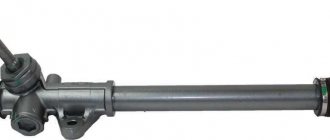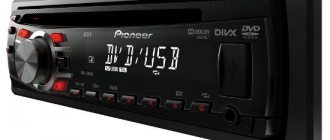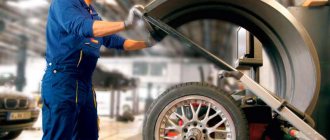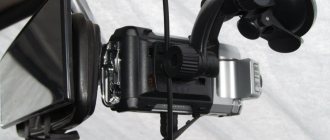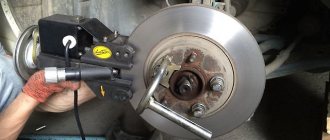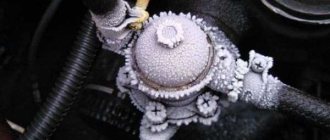Steering
The steering can be informative, sharp, light, soft... All these are figurative epithets that reflect the features of the system with the help of which the driver changes the direction of movement of a particular car.
And the steering can also be faulty. And there is no time for epithets, because due to play in the steering wheel or leaks, the car may not pass inspection and will not receive permission to participate in road traffic until the fault is fixed. That's how serious it is.
The most common type of steering in passenger cars is rack and pinion steering. For what reasons does it fail, what should the car owner know and do so that the steering components last as long as possible and do not require repair or replacement ahead of time?
Steering end
Statistically, the most troublesome parts in the steering are the tie rod ends. They are external and internal. The former connect the steering rod to the steering knuckle lever, the latter to the steering mechanism, which in rack and pinion steering is a rack. You can only expect trouble from the outer tips.
These tips are ball joints, consisting of a body with a bottom cover-plug, a ball pin, inserts made of polymer material, usually called crackers, and a spring, which presses the crackers against the ball head of the pin. On the side opposite the bottom cover, there is a boot cover that protects the internal cavity of the hinge from dirt. Although serviceable designs exist, most tips are lubricated during manufacture and are not renewed for the entire service life of the assembly.
The service life of the tip is regulated by the appearance of play in the joint of the ball head of the pin with the crackers. The weakest link is the crackers. They not only rub against the head of the pin, causing them to wear out, but are also damaged due to impacts transmitted during careless driving through holes at high speed, which can cause the material of the crackers to collapse.
The head of the finger wears out much more slowly, but is capable of rusting. The shells that cover the surface of the head work like a grater, accelerating the wear of the crackers.
For the head to begin to rust, moisture must get into the tip. It can penetrate inside the hinge through cracks and tears that appear in the dust cover, or if the edge of the hole in the cover becomes leaky.
Apart from wear and corrosion, there are no other reasons that necessitate replacement of tie rod ends. Accordingly, in order for the tips not to fail prematurely, only two conditions must be met - the absence of shock loads at the points of contact of the ball head of the pin with the liners and the tightness of the dustproof covers. To comply with the first condition, it is enough not to drive a car, counting all road irregularities at speed. The higher the speed, the stronger the impacts. Unfortunately, monitoring the anthers for cracks and tears only makes sense in structures where the cover can be replaced.
Steering rack
The tips are inexpensive, but the rack can leave you without pants, especially if its design is complicated by additional devices, as in the case of active steering.
However, although everything is moving towards the fact that hydraulics will give way to electricity, in most cars driving on the roads of Belarus, steering racks still remain hydraulic units, despite the addition of electric motors, gearboxes and control electronics.
Knocking and leaking are typical problems with power steering racks. The knocking sound of the rack is due to the wear of the teeth in the mesh of the steering shaft gear with the rack rod.
The teeth on the rod wear out differently: in the center, where they are constantly in use, faster than at the edges, where they are used only at extreme positions of the steering wheel.
If you hear a knock, it’s better not to hesitate to contact service. The problem itself will not “resolve”, but will get worse with a simultaneous increase in the amount that will be needed to fix the problem.
If the durability of racks with electric power steering is determined only by wear, then for the service life of racks with hydraulic power steering, the condition of the fluid that circulates through the system is important. One of the functions of liquid is lubrication. Over time, the properties of the liquid deteriorate. It ages, wear products of rubbing parts accumulate in it, as a result of which the liquid becomes dark and cloudy. This is an indication for replacing it, despite the fact that the list of maintenance work for most cars does not include a replacement procedure, and there are no drain plugs to remove old fluid.
As for leaks, their occurrence depends on the condition of the seals. They also wear out. Dirt and water can accelerate wear, and again, only dustproof covers can save you from external dirt.
They, like the anthers of the steering tips, crack from old age and tear. Problems with clamps can also cause boots to leak. Particular attention should be paid to their correct fastening after repair interventions.
When water gets under the boot, the rod rusts. The same story repeats as with the tip.
The rod moves back and forth and, with corrosion pits, quickly wears out the edges of the seals that seal the internal cavity of the rack body.
The oil seals are worn out and fluid leaks, so in the case of the rack, in order not to have to be repaired ahead of schedule, it is important to monitor the condition of the boots and replace them immediately if they break.
Power steering pump
Amplifiers are electrical and hydraulic. The former are the future, but in the Belarusian vehicle fleet so far “hydraulics” are in the majority. Depending on the method of driving the pump, which creates the necessary pressure in the hydraulic booster and ensures fluid circulation, there are two types of hydraulic boosters. In mechanical power steering, the pump is driven by a belt drive from the engine, and in electric power steering, it is driven by an electric motor.
Any pump creates pressure until wear appears on the working surface of the pump chamber and the edges of the blades rubbing along it, and the gaps between the ends of the rotor, blades and end caps of the pump housing become prohibitive. The rate of wear of rubbing parts greatly depends on the lubricant, which is power steering fluid. It was mentioned above that the liquid that has darkened and lost its transparency must be replaced.
However, the pump is even more sensitive to a decrease in the amount of liquid in the system due to a leak. A low fluid level is also undesirable because in addition to lubrication, the fluid also performs a cooling function. Dry work is like death. For racks, oil starvation is also detrimental, although the pump, as a rule, is the first to suffer from it.
Unlike conventional power steering pumps, which are tied to the engine by a drive belt and “threshing” all the time while the engine is running, power steering pumps work only when necessary due to taxiing conditions. Therefore, the service life of the pumps themselves, as well as the bearings, which in pumps of any of the two types are of concern even more often than the pump section, is longer. But the electronic components of the power steering are capable of presenting “surprises”.
The main reason leading to failure of electronic control units is moisture. And now the fact that the power steering pump is not connected by a belt drive to the car engine plays against it. The pump is often placed in places where it “bathes” in mud, in slush picked up from the road by wheels, or can be damaged by seemingly innocent contact with a snowdrift of compacted snow. For this problem, other than the need to monitor the integrity of the plastic dirt protection of the engine compartment from below and be careful when maneuvering, there is nothing else you can advise.
Eliminating knocking noise in the steering rack
If there is a knock in the steering rack, this is not a reason to run to a service center and spend tens of thousands of rubles on purchasing a new unit. Sometimes it is enough to simply unscrew the bolt securing the locknut and clean the spring.
Over the years of operation, a huge amount of dirt, rust and other deposits accumulate on the spring. As a result, the part becomes blocked and the bushing stops moving. To restore functionality you need to do the following:
- Unscrew the locknut and bolt (in the figure they are indicated by numbers 8 and 6).
- Remove the spring and bushing.
- Perform cleaning. To do this you will need chemicals and a brush. In extreme cases, you can use regular diesel fuel. But you need to be careful, it can damage the parts. Before cleaning, the spring is coated with lubricant.
- Particular attention should be paid to the bushing. There should be no damage to it; if there is any, the part must be replaced.
- Before installation, the bushing seat must be cleaned. Then the part is lubricated and installed in place.
- Reassembly is in progress.
This is interesting: Symptoms of a malfunctioning throttle position sensor and how to check
At the end of the work you will need to adjust the tightening. To do this, you will need a partner to drive. The tension bolt must be adjusted so that the steering rack does not knock. Once the optimal position is found, it is fixed with a lock nut.
Also, the reason why the steering rack is knocking may be the output bushing. This is part number 11 in the picture. Diagnosing its failure is extremely simple. Play in the output shaft is strong evidence of a malfunction. Replacing it won't be difficult. Just unscrew the old one and install the new one.
A complete replacement of the entire assembly is only necessary when dirt gets inside the rack structure, and this leads to destruction of the shaft and seal. Dismantling begins with releasing the steering tips. You also need to remove the bolts and universal joints. After this the installation is carried out.
The steering rack is biting, what should I do?
The steering can be informative, sharp, light, soft... All these are figurative epithets that reflect the features of the system with the help of which the driver changes the direction of movement of a particular car.
And the steering can also be faulty. And there is no time for epithets, because due to play in the steering wheel or leaks, the car may not pass inspection and will not receive permission to participate in road traffic until the fault is fixed. That's how serious it is.
The most common type of steering in passenger cars is rack and pinion steering. For what reasons does it fail, what should the car owner know and do so that the steering components last as long as possible and do not require repair or replacement ahead of time?
What are the signs of a faulty steering rack?
The steering rack is a mechanism responsible for turning the front wheels of the car and connected to them through rods. Like any other unit, the element gradually wears out during operation, which negatively affects the controllability of the machine. Since this problem is related to the safety of the driver and passengers, the car owner needs to recognize the signs of a faulty steering rack in order to fix them as soon as possible or install a new spare part.
Briefly about the mechanism
The element is a cylindrical body containing the following parts:
- the gear rack itself, moving inside the bushings;
- drive shaft with helical gear, rotating on 2 bearings (connected to the steering column);
- 2 rods connected to the ends of the rack and pinion mechanism and the steering knuckles of the hubs;
- a system of stops and springs that limit the travel of the rack and select the backlash of the gear transmission;
- rubber covers (anthers) in the form of round “accordions” that protect the mechanism crankcase from dirt;
- the element body is filled with liquid lubricant.
This is the design of a conventional mechanical and so-called electric rack, operating in conjunction with an electric power steering (EPS). If the car is equipped with a hydraulic booster (power steering), then the design of the mechanism is supplemented with cylinders and pistons that help move the gear bar in one direction or another.
The element works on a simple principle: when the steering wheel rotates, the drive shaft moves the rack through a gear in the required direction. The ends of the part connected to the rods cause the front wheels to turn. The power steering or electric power steering reacts to the movement of the steering wheel and “pushes” the rack and pinion mechanism in the desired direction, relieving physical stress from the driver.
Signs of trouble
Since most passenger cars are equipped with a hydraulic booster, wear symptoms should be considered in conjunction with the power steering elements - pump, control valve and oil lines.
Problems with the operation of the rack and pinion mechanism are divided into obvious and hidden. The motorist himself can identify the former while driving or as a result of inspecting components and assemblies. In the second case, the service station technician can clearly identify the fault. Your task is to react in time and contact a service station if the following symptoms appear:
- A knocking sound heard from the front of the car when driving over uneven surfaces, especially when turning. The sound location is approximately in the center where the rail is installed.
- When driving over small bumps or loose surfaces, vibration is clearly transmitted to the steering wheel.
- After completing a turn, the steering wheel reluctantly returns to its original position or remains turned. When you try to rotate quickly, the steering wheel becomes heavy.
- The free play of the steering wheel has noticeably increased, causing the car to “yaw” on a straight section of the road and requiring constant adjustment of the trajectory by the driver.
- Hum, whistle and other extraneous sounds.
- To turn, you have to apply a lot of force on the steering wheel.
- Critical failure - jamming of the mechanism or spontaneous rotation of the steering wheel without changing the direction of movement.
Note. The specificity of the knocking of the rack and pinion mechanism is its central location, which makes it seem to the driver as if the sound is coming from both sides at once. A confirming sign is vibration on the steering wheel and an increase in play.
If you can clearly determine that the steering rack is knocking, perform an external inspection of the unit. Pay special attention to the rubber boots - they are visible through the arches of the front wheels and partially under the hood. The best option is an inspection in a viewing ditch. Gusts and oil on the accordions indicate that water and dirt have entered the element, accelerating the wear of all parts.
Other external signs of failure are grease leaks on the unit casing. If you do not immediately notice a leaky oil seal, the oil level in the crankcase will drop and the so-called ring wear of the housing and power cylinder will begin. The consequences are an expensive replacement of the assembly.
If you have power steering, you need to inspect not only the rack, but also the power steering elements - pump, belt drive and oil hoses. Look into the expansion tank - a low level will immediately make it clear that lubricant is being lost as a result of a leak. Additional confirmation is fresh stains under the car at the place of permanent storage.
We wrote more about the problem in this article.
Unlike power steering, electric amplifiers do not show signs of malfunction and fail immediately. But such cases are rare; in general, the EUR is a fairly reliable unit.
Source: https://autotok66.ru/zakusyvaet-rulevaya-reyka-chto-delat/
Steering rack design
Steering racks of different types have different designs. The following types of slats are available:
- mechanical;
- hydraulic;
- electric.
It is important to consider the type of connection between the strut and the wheelbase (front-wheel drive, rear-wheel drive).
The mechanical structure consists of:
- gear rack;
- gears;
- shaft;
- steering gear;
- tips.
During the rotation of the steering wheel, a force is transmitted to the gear from the shaft, driving the rack. The rack converts rotational motion into translational motion and transmits it to the wheels.
In a mechanical design, the teeth change their pitch from the center to the edges, as a result of which it becomes more difficult to control the steering wheel at high speed and the maneuverability of the car is reduced. Modern cars, which are safe even at high speeds, are equipped with hydraulic and electrical mechanisms.
The hydraulic rack is attached to the body or to the engine - if located in the upper part. If the rail is located at the bottom, it can be mounted on a subframe, beam or body. What distinguishes it from a mechanical design is the presence of a hydraulic booster, which makes it easier to turn the steering wheel when maneuvering at high speed.
The electric rack is distinguished by the presence of an electric motor located on the left side of the vehicle steering unit. The electric model has a higher efficiency compared to its hydraulic counterpart. Its functionality does not depend on environmental conditions. Its design does not include oil seals, gaskets or hoses that require constant replacement due to wear. There is no need to constantly renew the lubricant, like mechanics, which break down every now and then due to a lack of lubricants.
Operating principle of the steering rack
In simple words, this is a device that connects the wheels to the steering wheel. The driver turns the steering wheel and through the steering shaft the force is transmitted to the gear, which rotates the gear shaft and moves the steering rods, and they turn the wheels.
Types of steering racks
There are three types of steering racks in modern cars:
- electrical;
- mechanical;
- hydraulic.
The mechanical steering rack has a simple device. At the end of the steering column there is a gear mechanism that is interconnected with a gear rack, which, in turn, communicates with the steering drive.
A hydraulic steering rack is implemented in most modern passenger cars. Power steering (power steering) increases the return on the effort exerted by the driver, and thereby ensures easy and comfortable driving.
The electric steering rack also improves the driver's response, but for this it uses an electric motor rather than a hydraulic booster.
The steering rack may be positioned differently in different car models. With the upper position of the rack, it is attached to the body and is located behind the engine; with the lower position, it is attached from below to the body, subframe or beam.
What causes the steering rack to fail?
How are you doing? Have the autumn blues overtaken you?
But the blanket won’t let me go, if you go out into the street, it blows on my neck, and depression lurks around every corner. I do not know what to do. But more on that later.
Today’s newsletter will be devoted to answering Igor Vladimirovich’s question about the steering rack: “ What causes the steering rack to fail?” Why does the steering rack leak and knock, and extraneous noises occur when turning the steering wheel and when driving on a rough road?
?»
As always, I’ll share my personal experience; shouldn’t you pickle it like cucumbers? When the time comes, it needs to be released in order to make room inside for another cucumber), so that this whole process of accumulation does not go in vain, so that everything that happened can work not only for you, but also for others.
Clients often ask: how to understand that it is the rack that is knocking?
The most obvious and noticeable symptom is a characteristic knocking sound when driving on uneven roads, which intensifies when turning the steering wheel.
In addition, there are other noticeable signs of a faulty steering rack:
- tight steering wheel - often the steering wheel turns tightly only in one direction;
- after parking, oil stains may remain on the asphalt in the area of the front of the car;
- hum in the power steering.
Typical situation
The causes of steering rack malfunction are usually the following:
- Having climbed the car onto a curb stone, you bent the steering rack shaft. Yes, we don’t have enough parking spaces in our city, so we drive onto curbs.
- moving through tram tracks at high speed. I agree, this doesn’t happen often, but still. Do you remember? And this loosens the steering rack and leads to increased wear of the gearing - as a result, the rack begins to leak, play, and knock.
- long-term (more than 5 seconds) holding the steering wheel in the extreme left or right position: this is when the steering wheel is turned all the way at high engine speeds. For example, you are stuck in a snowdrift, mud, or a pile of autumn leaves - this sharply increases the pressure in the system, leading to overheating of the oil.
FAQ
- > Home
- > Frequently asked questions
How long does it take to repair a steering rack/power steering pump?
What is the guarantee for the work performed?
What spare parts do you use for repairs?
How long can you drive a car if a leak is detected in the steering system?
Why adjust wheel toe angles after steering rack repair?
How do suspension problems affect the steering system?
What are the main signs of steering rack failure?
Are there special offers for wholesale customers?
How long does it take to repair a steering rack/power steering pump?
The repair time for the steering rack/power steering pump in most cases is 1-1.5 days. To do this, you need to make an appointment with us 1-2 days before your expected arrival date. On the day of the repair, you leave your car from 9 to 10 am and receive a work order with a preliminary repair amount (if the cost changes, we will contact you by phone to agree). The client is notified that the car is ready by telephone.
What is the guarantee for the work performed? The standard warranty for repair services is 6 months if you brought the unit dismantled and 12 months if the dismantling and installation work was carried out in our service center. More detailed information about the warranty conditions is provided here.
What spare parts do you use for repairs? To repair steering racks and power steering pumps, we use original components: CFW, Corteco, NOK, etc.
Why adjust wheel toe angles after steering rack repair? The toe-in angles of the wheels are controlled by the steering tips, which, in turn, are attached to the steering rack. Consequently, during dismantling and installation of the unit, they shift and, as a result, the toe angles are violated. In our service, we perform toe adjustment on a Hunter 3D stand, which allows you to accurately and very quickly carry out the adjustment procedure.
How long can you drive a car if a leak is detected in the steering system? When operating a vehicle, it is necessary to regularly check the levels of working fluids. If you notice that the level of hydraulic fluid in the expansion tank has decreased, it means there is a leak in the system. In this case, it is necessary to make an appointment for diagnostics and repair of the steering as soon as possible, since in this case, further operation will lead to failure of the power steering pump, and then the steering rack.
How do suspension problems affect the steering system? It's no secret that a car is an extremely complex mechanism, so the malfunction of one unit has, to one degree or another, an impact on other elements of the system. Thus, if there are faulty suspension elements, the steering rack is subject to increased load due to various backlashes and knocks, which can lead to its breakdown. That is why one of the conditions for providing a guarantee in our service is a working car suspension.
What is Servotronic? The Servotronic system allows you to increase the vehicle's handling by adjusting the force on the steering wheel depending on the speed of movement. Thus, at low speeds the steering wheel rotates very easily, improving the maneuverability of the car, while at high speeds the steering wheel becomes tight, which allows the driver to better “feel” his car and promotes safe driving.
What are the main signs of steering rack failure? The main signs that you should pay attention to are the following: knocking noises when turning the steering wheel, when driving on uneven roads, on rails
increased play in the steering wheel leakage of hydraulic fluid from the steering rack (usually accompanied by noisy operation of the power steering pump) stiff steering wheel when turning in one direction, while the steering wheel turns easily in the other direction tight rotation of the steering wheel when starting the engine, and after warming up there is a normal increase in rotation Manifestation of these symptoms indicates a malfunction in the operation of the steering system; if they are detected, you should immediately contact a car service center.
Are there any special offers for wholesale customers? We value our regular customers and work closely with many service stations both in St. Petersburg and in the regions of Russia. In addition to service discounts, we can interest you in the large assortment of steering racks and power steering pumps in stock and quickly select the necessary spare part.
We hope that we have sufficiently answered the most frequently asked questions by our customers. But we are always ready to provide additional clarification on points that interest you. Our managers are waiting for your calls by phone. (812) 305-25-07 , or by e-mail: mailto: [email protected]
Ford Focus steering rack repair: symptoms and causes of failure
19.11.2019
Issues discussed in the material:
- Why does the Ford Focus steering rack often fail?
- How does a faulty Ford Focus steering rack manifest itself?
- Why do Ford Focus car owners often confuse a broken steering rack with other faults?
- What are the features of repairing the Ford Focus steering rack of different generations?
- What parts must be changed when repairing a Ford Focus steering rack?
Everyone knows that the steering rack on Ford Focus cars of the first, second and third generations often breaks. This happens due to the harmful effects of many factors on the mechanism. If you drive aggressively, and the road is not in perfect condition, the fastening mechanisms are not tightened enough, corrosion will appear on the inner sleeve, the seals and rubber bands will break.
As a result, repair of the Ford Focus steering rack is inevitable. Moreover, the design features of this device are such that the mechanism will have to be completely changed. You will learn how to carry out repair work correctly from our article today.
Reasons for failure of the Ford Focus steering rack
Have you thought about repairing the Ford Focus steering rack because knocking noises have appeared? First of all, you need to understand how it is structured. The steering gear housing on the Ford Focus is located under the hood of the car, while the rack is bolted to the front suspension. There is also a special device on the steering column that absorbs shock energy when you drive on a bad road surface. In addition, a steering wheel position adjustment system and an anti-theft ignition mechanism are installed, which is responsible for blocking the wheels while the car is turning.
The steering system kit for this car model includes a switch block. They ensure proper operation of headlights, turn signals, and windshield wipers. Such a complex and well-thought-out control system makes driving a vehicle as comfortable and safe as possible. Therefore, if you notice any problems, you should immediately diagnose the car and, if necessary, repair the Ford Focus steering rack.
The Ford Focus has the following symptoms that indicate a malfunction of this mechanism:
- The most important sign indicating that repairs are inevitable is creaking when turning the steering wheel, when the engine is running and the car is parked or moving at low speed. The extraneous sound will be similar to rubber rubbing: first there will be a squealing sound, then the squeaking will become stronger after the engine has warmed up and has been running for quite a long time. Note! When the device is faulty, the squeaking noise will be similar to the friction of the gaskets located next to the driver's seat. For this reason, some car owners cannot find the true reason for the appearance of extraneous sounds. Sometimes the squeaking may stop, but over time it will appear again.
- The fact that the Ford Focus steering rack requires repair is indicated by the appearance of a single tapping sound. The sound comes from the right and sounds like a stabilizer bar knocking. The tapping sound can be heard when you are driving at low speeds and making turns, such as parking. Over time, the sound becomes constant.
- In addition to extraneous noise, other symptoms may appear that indicate that the Ford Focus steering rack, which has failed, requires repair. For example, increased sensitivity of the steering wheel: vibrations appear, as if you are driving on a bad road surface. Important! If the device fails, signs of failure will be intermittent. Extraneous sounds may appear and disappear, so the driver is not always able to understand whether repairs need to be made. However, over time, creaking noises will be heard constantly while driving.
- When turning the steering wheel left or right, you may feel a vibration. This sign indicates that there is play between the rack parts.
- If the steering wheel has become stiff and you have to spend a lot of effort to rotate it, then you should repair the Ford Focus steering rack.
It is also necessary to remember that there are some signs that indicate that the adjusting bolt is not tightened enough, but the device does not need to be repaired.
You should not only know the symptoms of the malfunction, but also understand why the breakdown occurred. For example, if you notice knocking noises and the free play of the steering wheel has increased, this means that the thrust spring is not tensioned enough, or the ball joint or cardan joint is worn out, or the steering mechanism mounting bolts are not tightened properly.
Has the steering wheel become stiff and you have to exert a lot of force to turn it? This means that the power steering pump drive belt is slipping or has become unusable, air has entered the hydraulic system, the working fluid level is low, the hoses are torn or twisted. This symptom also occurs when the pump pressure is low or there are leaks in the pump or steering gear.
The reason that the steering wheel does not go to the center position may be that the stop spring is not tensioned enough, the internal hinges or tip hinges are difficult to turn.
“Replacing injectors in a Nissan: complete instructions for owners” Read more
Tapping and noises indicate that the fastenings of the rods, steering gear, and ball ends of the rods are loose. Worn rods and ball joints can also cause this symptom.
No matter what kind of breakdown occurs, you should immediately go to a service center, where a technician will diagnose and perform the necessary repairs.
Diagnostics
First you need to make sure there is a problem. To do this, you need to turn off the engine, having first placed the car on the inspection hole. Then you need to turn the steering wheel several times until it stops in one direction and the other.
At the same time, at least two people are needed to determine the malfunction. One will turn the steering wheel, the other will evaluate the work of the rack from below. This will allow you to check for any gaps in the hinges. If the knocking noise remains even after disconnecting the rods and levers, the unit will have to be replaced.
There can be many reasons why the steering rack knocks. Therefore, diagnostics plays a huge role in repairs. The most common knocking noises are the tie rod ends and rods. The main sign of a torn tip is a damaged boot. It is because of this that the ball joint becomes unusable. Diagnosing a broken rod is much more difficult.
This is interesting: The car does not start when the starter is spinning - how to fix it?
Unfortunately, it is difficult to verify that the steering rack is knocking precisely because of traction, because if the car was purchased with mileage, then the previous owner could easily replace the torn spare part without bothering with more serious repairs.
Important! To understand that the steering rack is knocking precisely because of the traction, you need to remove the boot and check the traction for any play.
In most cases, the reason why the steering rack knocks is the bushing. This is part number 7 in the picture. It does not have a rigid fixation and is pushed forward by a spring, which is adjusted by a bolt with a lock nut.
Important! Most service centers, instead of replacing only the bushing, offer to install a new unit.
Most often, such a policy of service centers is associated with a banal desire to make money from the motorist. Indeed, there are parts that change only during assembly. But this is not the case. The bushing for Honda cars is available for public sale. Moreover, you can do it yourself if you have the drawings.
Noise when turning
If you hear a hum when the steering wheel is turned to its extreme (or close to it) position, it means that you need to check the condition of the hydraulic or electric booster and the components of its working system. In this case, a hum may occur even if the fluid level is normal. You need to check the condition of the pump blades (often, over time, the pump’s performance decreases), the condition of its bearings, and the tension of the drive belt.
Power steering fluid leak
Regular leakage is a reason to check the power steering system and its seals. In particular, if the car owner is forced to frequently add fluid to the system’s expansion tank. In this case, a concomitant symptom of a faulty steering rack will be a fluid leak from the line. It can drain directly onto the ground under the car (usually right under the expansion tank) or streaks can be seen on the steering linkage boots.
Often, when a liquid leaks, air enters the system (the system is “aired”). It can be seen by the bubbling liquid in the expansion tank. As stated above, the cause of the leak may be rust on the rack. To get rid of it in the future, it is advisable to use non-standard plastic clamps to tighten the anthers, and their metal counterparts, which provide a higher level of tightness.
Knock when driving in the front axle
In fact, such a knock may also indicate a malfunction in the vehicle’s chassis, so additional diagnostics must be performed. The knock can be either in the center or on the left or right side. In the best case, a knock may indicate a torn traction boot; in the worst case, it can indicate problems with the rods, levers or other elements.
To understand exactly why such a malfunction occurred, it is better to remove and disassemble the rack. After all, the most harmless thing may be a loose adjusting nut or wear of the bushing (when there is a knock on the right), but a more serious problem is wear of the worm pair.
Torn boot on traction
When checking the performance of the rack, it is necessary to pay attention to the integrity of the traction boot. Ideally, it should be intact and the rubber should be elastic. If it is torn and dirt has gotten inside, it must be replaced, lubricant must be added after removing dirt, moisture, and debris from the mechanisms.
Electric power steering rack
To localize faults in the electric steering rack, it is necessary to check the following elements.
What are the signs of a faulty steering rack?
The steering rack is a mechanism responsible for turning the front wheels of the car and connected to them through rods. Like any other unit, the element gradually wears out during operation, which negatively affects the controllability of the machine. Since this problem is related to the safety of the driver and passengers, the car owner needs to recognize the signs of a faulty steering rack in order to fix them as soon as possible or install a new spare part.
